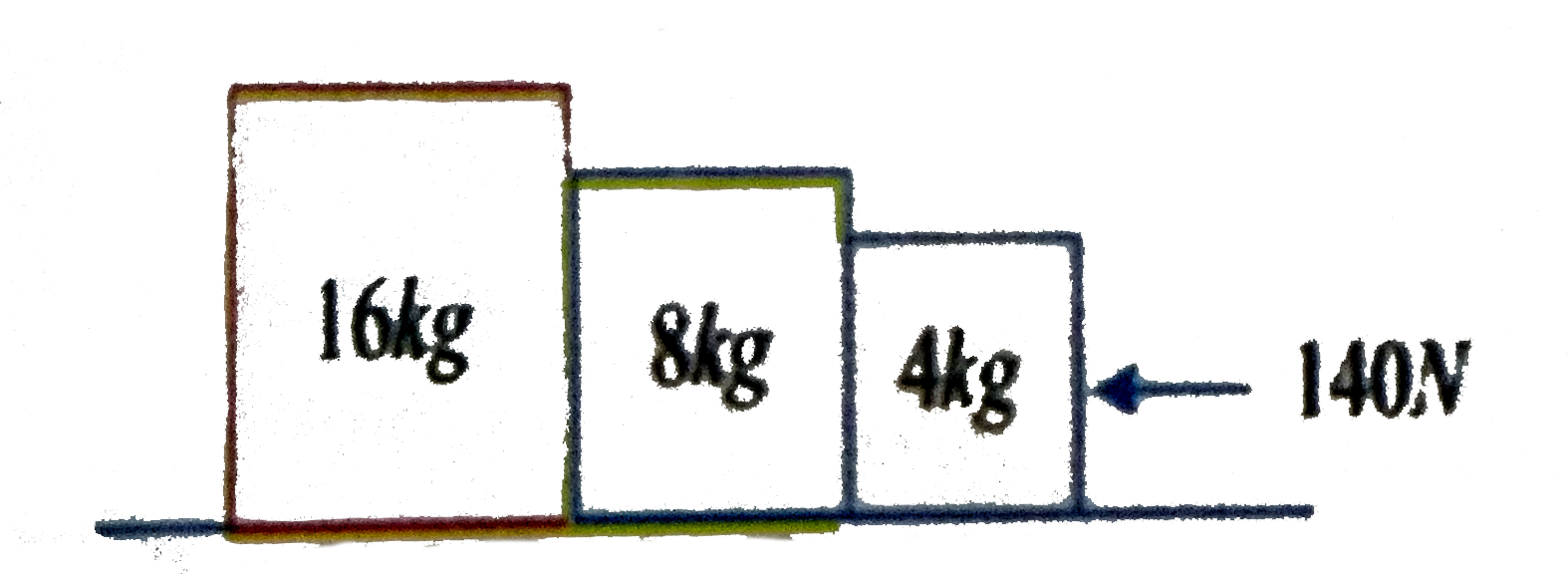A bomb of mass 8 Kg exlpodes on a smooth horizontal surface , into three fragments of masses 1 Kg , 3 Kg and 4Kg . 4Kg fragment moves with a speed 1 m/ s along eastward and 3 Kg fragement moves with a speed 1 m/s along northward . find the magnitude and direction of the velocity of 1Kg fragment .Solution in Bengali

According to the law conservation of momentum . From the figure we get ,
along east - west direction ,1 vcosθ=4×1
or vcosθ=4
along north - south direction 1⋅vsinθ=3×1
or vsinθ=3
∴, v2(cos2θ+sin2θ)=42+32
or v2=25or,v=5m⋅s−1
Again ,vsinθvcosθ=34
or,tanθ=34or,θ=tan−134
∴ the velocity of the 1Kg fragement is 5m⋅s−1 in a direction making an angle of tan−1(3)4 south odf west .
Topper's Solved these Questions
- BOOK - CHHAYA PUBLICATIONCHAPTER - WBCHSE QUESTION PAPER -2019EXERCISE - SECTION - II ( GROUP -D)10videos
WBCHSE QUESTION PAPER -2019
- BOOK - CHHAYA PUBLICATIONCHAPTER - WBCHSE QUESTION PAPER -2019EXERCISE - SECTION - II ( GROUP -B)8videos
WBCHSE QUESTION PAPER -2019
- BOOK - CHHAYA PUBLICATIONCHAPTER - VISCOSITY AND SURFACE TENSIONEXERCISE - EXERCISE (CBSE SCANNER)9videos
VISCOSITY AND SURFACE TENSION
- BOOK - CHHAYA PUBLICATIONCHAPTER - WORK AND ENERGYEXERCISE - CBSE SCANNER27videos
WORK AND ENERGY
Similar Questions
Equations of trajectory of a projectile are x=4 t, y=3t−5t2 , where x and y are in metre and t is in second . Find (i) maximum height attained by the projectille , (ii) horizontal range of the projectile .
01:47View SolutionA particle moves with uniform acceleration and the distance travelled in t - th second is st=3+2t . Find the initial velocity of the particle .
03:22View SolutionState and prove Bernoulli's theorem.
03:00View SolutionProve that the total mechanical energy remains constant for a ball mass m dropped from a tower of height h.
02:32View SolutionA bomb of mass 3.0 kg explodes in air into two pieces of masses 2.0 kg and 1.0 kg . The smaller mass goes at a speed of 80 m//s . The total energy impared to the two fragments is :
01:12View SolutionA bomb of mass 16kg at rest explodes into two pieces of masses 4kg and 12kg. If KE of 4kg mass is 288J, what is the velocity (in ms−1 of the other piece of 12kg ?
05:49View SolutionThree masses of 16kg,8kg and 4kg are placed in contact as shown in Figure. If a force of 140N is applied on 4kg mass, then the force on 16kg will be
 03:33View Solution
03:33View SolutionA bomb of mass 3.0 kg explodes in air into two pieces of masses 2.0 kg and 1.0 kg . The total energy imparted to the two fragment is
03:04View SolutionTwo particles of mass 1 kg and 0.5 kg are moving in the same direction with speed of 2 m//s and 6 m/s respectively on a smooth horizontal surface. The speed of centre of mass of the system is
05:37View SolutionA body of mass 5 kg explodes at rest into three fragments with masses in the ratio 1 : 1 : 3. The fragments with equal masses fly in mutually perpendicular directions with speeds of 21 m/s . The velocity of the heaviest fragment will be
View SolutionA shell at rest at origin explodes into three fragments of masses 1 kg, 2 kg and m kg. The fragments of masses 1 kg and 2 kg fly off with speeds 12 m//s along x-axis and 8 m//s along y- axis. If the m kg piece flies off with speed of 40 m//s then find the total mass of the shell.
01:07View SolutionA body of mass 5 kg explodes at rest into three fragments with masses in the ratio 1 : 1 : 3. The fragments with equal masses fly in mutually perpendicular directions with speeds of 21 m/s. The velocity of the heaviest fragment will be -
01:36View SolutionA body of mass 1 kg moving in the x-direction, suddenly explodes into two fragments of mass 1/8 kg and 7/8 kg. An instant later, the smaller fragment is 0.14 m above the x-axis. The position of the heavier fragment is:
View SolutionThree masses of 16 kg, 8 kg and 4kg are placed in contact as shown in Figure. If a force of 140 N is applied on 4kg mass, then the force on 16kg will be
 04:58View Solution
04:58View SolutionA bomb of mass 60 kg moving uniformly with a velocity of 10m/s explodes spontaneously into two fragments of 40 kg and 20 kg. If the velocity of the larger fragments is zero, then calculate the velocity of the smaller fragement.
01:35View Solution

